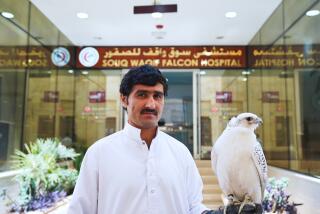Jordan Hopes Big Balloon Race Will Help to Lure Adventurous Tourists to Desert
- Share via
WADI RUM, Jordan — The pink and purple peaks and peach-colored sands of Lawrence of Arabia country fall away as a flight of balloons soar into the air.
It was on these sands of Wadi Rum in present-day Jordan where a young British army officer T. E. Lawrence gathered troops in the Arab revolt against the Turks in World War I.
More than 70 years after Lawrence rode here on his way to the battle of Aqaba, the kingdom is trying to lure adventurous tourists by hosting a competition it hopes will eventually be followed by its own balloon rides.
“This is some of the most spectacular scenery in the world,” says Graham Dorrell, piloting one of 50 balloons in the first event of its kind in the Middle East.
His passengers peer over the side of the basket into thin air, the heat of the flaming gas breathing down their necks as the craft rises at 700 feet per minute.
As the balloon hangs suspended at 8,000 feet, a giant Moorish castle floats by in the clear blue sky like a child’s dream or an adult’s hallucination.
On the ground, puzzled Bedouins stare at huge inflatable whisky bottles, jumbo jets and a gigantic floating newspaper thousands of feet in the air.
“What is that?” a circle of desert policemen astride camels ask a foreigner, pointing at a giant floating champagne cork.
“We looked up on the left to a long wall of rock, sheering in like a thousand-foot wave to the middle of the valley,” wrote earthbound Lawrence on his first glimpse of “this irresistible place; this processional way greater than imagination.”
Jordan, promoting its tourist attractions, is exploring the possibility of offering balloon rides for travelers beginning next year.
The recent event featured 50 world and national champions flown in from Europe and North and South America, including holders of distance, altitude and more exotic records.
“At one point we thought we were going to die--we had problems with the pilot (flame),” said Andy Elson, 39, from Bath, England, of his ground-breaking trip over Mount Everest five years ago.
He said it took three hours to fly over Everest and another four days to drive back around the mountain in a $1 million trip that took three years to plan.
Other pilots participating in the Jordanian event included world champion Per Lindstrand from Sweden, who flew 3,000 miles across the Pacific last year.
Despite his experience, he was believed lost for several hours in Wadi Rum on the first day of competition when his recovery team had trouble finding him after he landed.
American Steve Jones was declared the overall winner of the three-day event, winning the $5,000 first prize in the Royal Jordanian Airlines-sponsored competition that ended Nov. 17.
On some days the buffeting desert winds kept balloonists grounded for hours.
Pilots said anyone in danger of straying to Israel or Saudi Arabia could land before crossing the line.
Hot-air balloons, which usually cost between $9,000 and $45,000, have become big business, flying over cities and landmarks to advertise everything from scotch whisky to newspapers to messenger companies.
Balloonists can get a basic license in a 10-day course, learning how to control the propane-generated heat to make the craft rise or fall, plot courses and fold and unfold up to 3 1/2 miles of rip-stop nylon from which the balloon is made.
According to veterans, balloonists are killed in the air only on the rare occasions of collisions with power lines or one another or if the propane burners fail.
“This is the safest form of aviation,” said Dorrell, who works for Britain’s Virgin Airship Balloon Co., one of the biggest balloon companies in the world.
“The only thing that is not so peaceful sometimes is the landing,” he said.
More to Read
Sign up for The Wild
We’ll help you find the best places to hike, bike and run, as well as the perfect silent spots for meditation and yoga.
You may occasionally receive promotional content from the Los Angeles Times.






